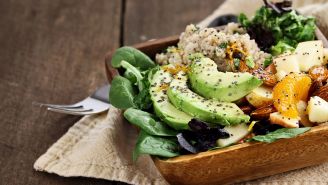In a society that’s become so focused on losing weight, it’s second nature for many people to check nutrition labels for a single number: calories. And while calorie counts can be important, they don’t tell the whole story about the healthfulness of a food. Nutrition labels offer plenty more information about fat, protein, sodium, sugar, vitamins, and minerals.
Here’s what you should be looking for when putting together your eating plan.
Variety is the spice of life
A healthy diet consists of getting enough nutrients from a wide variety of foods, including fresh produce, 100 percent whole grains, and lean proteins. To build a well-balanced meal:
- Load at least half your plate with fruits and vegetables.
- Round out your dish with a 3-ounce serving of lean protein, like chicken or fish—about the size of a deck of cards or a checkbook—or a healthy serving of a plant-based protein like tofu or beans.
- Measure out 1/2 cup of cooked whole grains, like brown rice or quinoa.
A veggie-heavy meal might help you eat less fat, fewer refined carbohydrates, and a smaller amount of unnecessary calories. You can save money and make sure you’re eating the freshest produce possible by choosing fruits and veggies that are in season.
If you’re including packaged foods in your meal, take a look at nutrition labels to better understand the ingredients.
Which nutrients should I limit and which should I add?
Nutrition labels provide insight about the nutrients in each serving, but they won’t tell you how much to eat to keep your body functioning properly.
Check your labels for fat, sodium, cholesterol, and added sugars, all of which should be low in your diet. Here’s what to limit:
Fat: Our bodies need healthy fats, like the omega-3 fatty acids found in salmon or trout and the monounsaturated fats found in olive oil. Healthy fats help reduce levels of low-density lipoprotein (LDL)—aka, “bad” cholesterol—and help your body produce cells. Eating healthy fats may even reduce your risk of heart disease and stroke.
Saturated fats found in red meats, processed meats, butter, and cheese, on the other hand, should be limited to 10 percent of your daily calories or less. Too much saturated fat in your diet can increase your risk of stroke and heart attack. Trans fats are especially bad news. They lower levels of high-density lipoprotein (HDL)—aka, “good” cholesterol—raise levels of bad cholesterol and increase your risk for type 2 diabetes, stroke, and heart disease. It’s best to eliminate trans fats from your diet as much as possible.
Sodium: A diet high in sodium may force your kidneys to work harder to dilute the excess sodium in your bloodstream. High sodium intake is also linked to elevated blood pressure. To reduce these risks, limit your intake to 2,300 milligrams a day. Avoid processed foods and foods like bacon and salted nuts to cut these numbers, and go easy on the salt shaker at meals.
Cholesterol: Another contributor to an elevated risk of heart disease is too much LDL cholesterol. Fried foods, processed meats like sausage, and packaged foods like muffins and other baked goods tend to be high in cholesterol and saturated fats, both of which may increase your LDL cholesterol levels.
You can help protect your heart by keeping your cholesterol intake to moderate levels. Foods high in cholesterol typically contain high levels of saturated fat, so diets that limit both of these tend to be healthier. But dietary cholesterol alone is not completely bad, so it pays to choose your cholesterol intake wisely. Eggs, for example, may be high in cholesterol (210 milligrams per large egg), but they’re low in saturated fat and contain other nutrients that may actually help lower heart disease risk.
Sugar: Not all sugar is bad for our bodies, but excessive added sugar can hurt your health. Eating fresh fruits, which contain plenty of natural sugar, is essential, but a diet high in added sugar can contribute to weight gain and up your risk of heart disease. The American Heart Association recommends limiting daily added sugar consumption to about 100 calories for women and 150 calories for men.
Meanwhile, you’ll want to look for foods high in vitamins, minerals, and more. Here’s what to aim to add to your diet:
Vitamin A: This vitamin is important for maintaining normal vision and a healthy immune system. The recommended daily intake of vitamin A is 2,333 to 3,000 international units (IU). Getting too much of a certain type of vitamin A often found in supplements can result in dizziness, nausea, and in worst-case scenarios, coma and death. If you’re pregnant, it might even cause birth defects.
So, what’s the best way to get vitamin A? Eat plenty of colorful fruits and veggies like sweet potatoes and carrots, each of which contain more than 100 percent of the recommended daily amount per cup. The type of vitamin A found in fruits and veggies is safe to eat, even in large amounts.
Vitamin C: Abundant in kale and yellow bell peppers, vitamin C is needed for the growth and repair of your body’s tissues. Men should aim for 90 milligrams of vitamin C a day, while women should shoot for 75 milligrams. Smokers should try for at least 35 milligrams more daily than non-smokers. A single cup of kale contains 80 milligrams of vitamin C, and one whole yellow bell pepper contains 340 milligrams of the vitamin.
Fiber: In addition to promoting normal bowel function, dietary fiber helps control blood sugar levels. Women need about 25 grams daily, according to the National Academy of Medicine, and men require about 38 grams. Foods like black beans contain 15 grams per cup, and raspberries, 8 grams per cup.
Calcium: Milk isn’t the only source of calcium, which is important for bone and tooth health. Produce like oranges and broccoli contain a decent amount—72 and 43 milligrams per cup, respectively. Getting about 1,000 milligrams of calcium per day is acceptable for most adults.
Iron: Iron is an essential part of the protein that carries oxygen from the lungs to the rest of the body. Women between ages 19 and 50 should get about 18 milligrams daily, while men and women over age 50 should get about 8 milligrams. It may not seem like a lot, but many struggle to reach this goal. A cup of red kidney beans contains more than 5 milligrams of iron, and the same serving of black beans contains just under 4 milligrams.
Track your progress
The U.S. Food and Drug Administration (FDA) has set guidelines for recommended daily intake of nutrients based on a 2,000-calorie diet. These guidelines are a good starting point, but talking to your healthcare provider is the best way to ensure you’re following a plan that’s appropriate for you.
An easy way to make sure you’re reaching these marks is to track your diet. Mobile apps help you do just that. In addition to tracking calories, some apps calculate the nutrients you’re eating throughout the day. The Sharecare app also offers information about healthy meals and portion size, although it doesn’t track calories.
Before you start tracking your diet, get a better understanding of your overall health by taking the RealAge Test. This assessment measures how your lifestyle and habits affect your longevity. You’ll receive personalized recommendations for lowering your RealAge, which might include making healthy tweaks to your diet.







